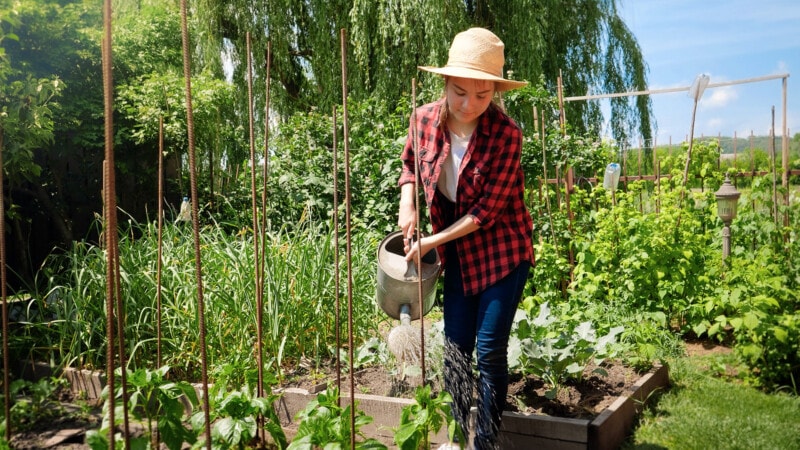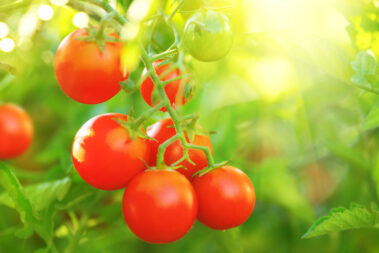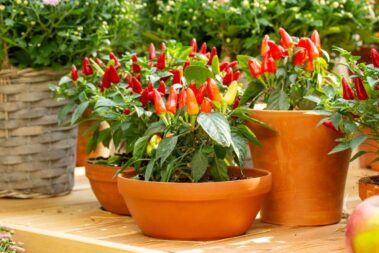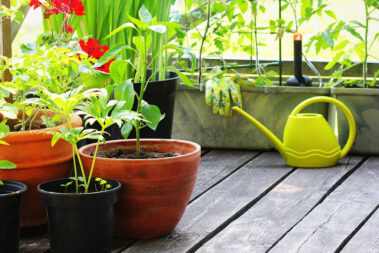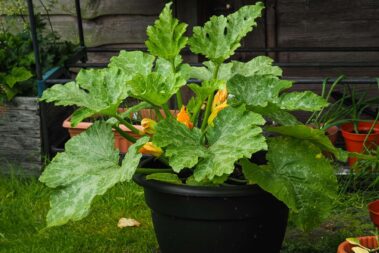As the heat of summer rolls through, so many of our favorite spring veggies begin to bolt or die off. But that doesn’t mean you have to finish out the year with bare spots in your garden.
There are plenty of veggies that can be planted during the summer for a bountiful harvest once the leaves begin to turn.
If you’re wondering what to plant in a fall vegetable garden, we’ve got you covered. Below is a list of 22 vegetables that are perfect for helping you extend your gardening season straight into the cooler months. We’ll also help you plan the timing for your fall garden so you can find success no matter your climate.
Table of Contents
What Can You Plant in a Fall Vegetable Garden?
Fall vegetables have one of two traits: they are either fast growers or are relatively hardy when it comes to frost. But not all fall produce can be grown in all climates.
Below, we’ve described what makes each choice perfect for the average autumn garden as well as highlighting which climates that choice is optimal for. By choosing the right plants for your particular zone and weather considerations, you’ll be much more likely to find success.
Arugula
Arugula is a cool season lover that also grows very quickly, making it the perfect choice for your fall garden. This open-leafed lettuce is frost tolerant and very hardy. And if you haven’t gotten your arugula fill by the time winter rolls around, you can always throw a cold frame over it and keep growing it right through the cold months.
A great choice for: Climates with short autumns and unpredictable frosts.
When to sow: 4 to 7 weeks before the first frost
Beans
Bush beans are a heat-loving summer veggie that grow impressively fast. This makes them a great candidate for midsummer planting. They don’t produce well once the days get too cool, but they grow fast enough to provide a plentiful harvest before summer gives way to autumn.
A great choice for: Climates with hot Augusts and Septembers or extended summers.
When to sow: 10 weeks before the first frost
Beets
Beets are a semi-hardy veggie that prefers cooler temperatures. Growing them in the fall tends to produce better results than in the spring because the colder temperatures after maturation bring about brighter colors and a sweeter taste.
A great choice for: Climates with long, mild falls
When to sow: 8 to 10 weeks before the first frost
Broccoli
Broccoli is frost-hardy but takes a long time to mature. They can be a little tricky to time right in fall, but it is well worth it. The florets will have a sweeter flavor and you are likely to get a bigger harvest from plants grown at the end of the season.
A great choice for: Climates with long, mild falls.
When to sow: 12 to 14 weeks before the first frost.
Brussels Sprouts
Brussel sprouts are a long-season crop that is frost-hardy. In most climates, this relative of broccoli is planted in early spring for a fall crop. But in very mild climates, it can be sown in fall for a winter crop.
A great choice for: Climates with long, mild falls or mild winters.
When to sow: 14 weeks before the last frost.
Cauliflower
Cauliflower is a touch on the picky side. This veggie likes it cool but not too cold. They will not produce heads in hot or cold weather, so getting the timing right can be very difficult. Choosing a variety with a maturity time that matches your climate is key.
A great choice for: Climates with long mild autumns.
When to sow: 8 to 12 months before the first frost.
Celeriac
Celeriac, also known as celery root, is another cold-loving, long-growing crop. Like other root vegetables, it gets sweeter after being exposed to cold temperatures and is a great candidate for fall harvesting if your climate has what it takes to grow it.
A great choice for: Climates with wet summers and late frosts.
When to sow: 17 weeks before the first frost.
Collards
This hardy green is a great choice for fall gardens whether you live in the south or a little farther north. Collards are cold-hardy and produce deliciously sweet leaves in the cooler months. They take a little longer to mature but can withstand light freezes as well as hotter temperatures.
A great choice for: Most any climate, just allow ample time for maturation before the first freeze.
When to sow: 10 to 12 weeks before the first freeze.
Garlic
Did you miss the boat on mid-summer planting? You still have a chance to fill in those holes in your garden with garlic. This allium is made to mature overwinter for a late spring harvest. You won’t be able to enjoy it in the autumn, but it will give you a way to extend your gardening season deep into fall.
A great choice for: Any climate with a cold winter (be sure to mulch the cloves in harsher climates).
When to sow: Mid-fall for a spring harvest.
Green Onions
Green onions, like most alliums, are very cold-tolerant. Plus they mature very quickly and will regrow after every harvest. These veggies only take about a month to mature but plant them early in the fall to get multiple harvests in before the snow flattens them.
A great choice for: Climates with short, unpredictable autumns.
When to sow: At least 4 weeks before the first frost.
Kale
Kale is another exceptionally hardy vegetable that can be grown in fall or through winter with the help of a cold frame. It takes a bit longer to mature than other greens, but can always be harvested in the “baby kale” phase if the weather turns before the plant has reached full size. Plus, this green is fairly heat-tolerant, so it can be started earlier in the summer if needed.
A great choice for: Climates with unpredictable autumns.
When to sow: 8 to 11 weeks before the first frost.
Kohlrabi
Kohlrabi is a cold-hardy plant that prefers temperatures under 75 degrees to grow. In many zones, this tough veggie will live through the winter without any help.
A great choice for: Climates with cool autumns.
When to sow: 7 to 9 weeks before the first freeze.
Lettuce
There are a million varieties of lettuce. Some mature quickly and some take a bit more time. But all make great choices for the fall garden since they grow best in cool weather.
A great choice for: Climates with cool falls of variable length.
When to sow: 4 to 8 weeks before the first frost.
Mustard Greens
Mustard greens are frost-hardy and mature relatively quickly, making them a great fall vegetable for a variety of climates. Some types are more heat tolerant than others, but all grow well in the cool autumn months.
A great choice for: Most climates with cool falls.
When to sow: 6 to 8 weeks before the first frost.
Parsley
Parsley is a cool-season herb that does exceptionally well in fall because there is no risk of bolting. This plant is also freeze-tolerant and can survive temperatures as low as 10 degrees. In mild climates, it can be grown straight through the winter.
A great choice for: Climates with unpredictable frosts and those with mild winters.
When to sow: 9 to 11 weeks before the first freeze.
Parsnips
Parsnips are a hardy root veggie that taste best when harvested after a hard freeze. They are very cold tolerant but take a long time to reach maturity. In mild regions, they can be harvested throughout winter right into spring.
A great choice for: Climates with long autumns or mild winters.
When to sow: 14 to 17 weeks before the first freeze.
Peas
Peas are the poster child of the spring garden, but they also do well in autumn in certain climates. Most varieties do not like heat, but some can grow fairly well in warmer months. They are cold tolerant but should be harvested before the first freeze.
A great choice for: Climates with medium to long autumns.
When to sow: 9 to 12 weeks before the first frost.
Radicchio
Radicchio is a cold-tolerant plant that grows best in cool weather with plenty of sunlight. In mild regions, it can be grown during the winter. But for most climates, you’re best off sowing seeds in mid-summer for harvest around the time of the first frost.
A great choice for: Predictable, long autumns.
When to sow: 11 to 13 weeks before the first frost.
Radishes
Radishes are some of the fastest maturing cool-season crops. Some varieties take less than a month to reach maturity from the day they’re sown. Like other root veggies, the flavor is often better when harvested after a frost.
A great choice for: Climates with short, unpredictable winters.
When to sow: 4 to 8 weeks before the first frost.
Spinach
Spinach is another super-hardy green that can be grown in fall. This cold-loving plant can even be grown in a cold frame in areas with harsher winters. Most varieties are not heat-tolerant, however, so be sure the weather has cooled before you sow these seeds.
A great choice for: Climates with shorter autumns.
When to sow: 6 to 7 weeks before the first freeze.
Swiss Chard
Swiss chard isn’t as cold-tolerant as some other greens, but it can withstand light frosts. It also has a relatively short maturation period, which makes it a prime choice for the fall garden.
A great choice for: Climates with mild autumns and predictable frosts.
When to sow: 8 weeks before the first frost.
Turnips
Turnips are a cold-loving root vegetable that can be harvested throughout fall. The greens can be harvested as early as 5 weeks after sowing. The root can be harvested soon after if you want small, tender turnips, or after the first frost for full-sized, sweeter turnips.
A great choice for: Climates with unpredictable frost dates.
When to sow: Up to 9 weeks before the first frost.
When Should You Start Fall Crops?
There are three key factors that play into when you should plant your fall garden:
- How long each crop takes to reach maturity.
- How cold-tolerant each crop is.
- And how heat-tolerant each crop is.
Crops that have some heat tolerance can be planted much earlier in the summer than those that will only grow well in the cool months. Alternatively, those that can withstand some mild freezes, can be planted much later into autumn.
Both these factors must be balanced with how long it takes the plant to mature.
A crop that takes more than 8 weeks to reach maturity and has very little heat tolerance requires a long autumn. Alternatively, crops with short maturation periods and some cold tolerance are perfect for climates with short falls and unpredictable frosts.
Bottom line: most fall crops should be sown in mid to late summer but you will have to adjust your dates based on how long the crop takes to reach maturity, how hot your weather currently is, and how quickly it’s likely to get too cold.
You may find that your climate does not allow for a fall crop of certain veggies due to too much heat or a too-early frost. But the best way to find out for sure is to experiment with a variety of plants and a variety of planting dates.
- How to Pick the Perfect Watermelon For a Sweet Summer Treat - April 10, 2024
- Future Kind’s Foundations: A Multivitamin Made for Vegans - December 5, 2023
- Does Nutritional Yeast Go Bad? - November 28, 2023

